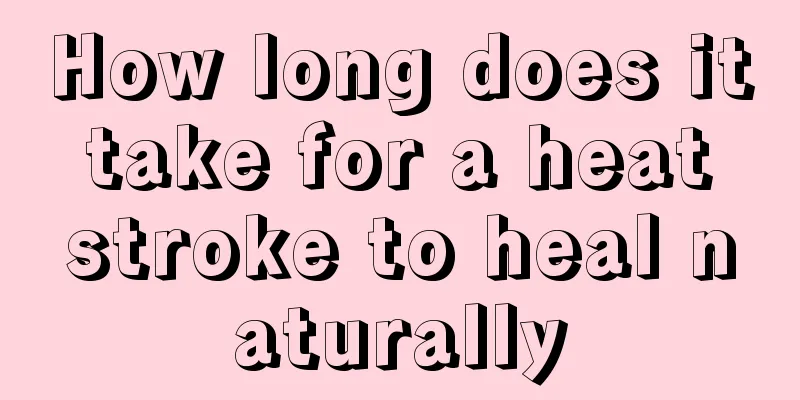How long does it take for a heat stroke to heal naturally

|
In the hot summer, many people will suffer from heat stroke due to direct exposure to the sun. Heat stroke often manifests itself in symptoms such as fever, weakness, and fainting. Especially for outdoor workers, they must pay attention to preventing heatstroke. Once they have heatstroke, if preventive measures are not taken in time, more serious complications are likely to occur. So how long does it take to recover naturally from heatstroke? Heatstroke is an acute disease with central nervous system and/or cardiovascular dysfunction as the main manifestations, caused by dysfunction of the temperature regulation center, failure of sweat glands and excessive loss of water and electrolytes in the hot summer season, high temperature and/or high humidity environment. Based on clinical manifestations, heatstroke can be divided into premonitory heatstroke, mild heatstroke and severe heatstroke. Among them, severe heatstroke is divided into heat cramps, heat exhaustion and heat stroke. Heat stroke is the most serious type of heat illness. Causes 1. Increased heat production Working in hot seasons or in high temperature, high humidity and poorly ventilated environments, and insufficient heat prevention and cooling measures. 2. Reduced heat dissipation High ambient temperature and humidity, poor ventilation, sweat gland dysfunction, etc. 3. Decreased body heat adaptability The elderly and infirm, women in the postpartum period, and patients with underlying diseases such as cardiovascular and cerebrovascular diseases have relatively weaker ability to adapt to heat and are more likely to get sick in the same environment. Clinical manifestations According to my country's "Diagnostic Standards for Occupational Heat Stroke" (GB11508-89), heat stroke is divided into premonitory heat stroke, mild heat stroke and severe heat stroke. 1. Premonitory heat stroke In a high temperature environment, symptoms such as headache, dizziness, thirst, sweating, weakness and soreness in the limbs, inattention, and uncoordinated movements may occur, while the body temperature is normal or slightly elevated. 2. Mild heat stroke In addition to the above symptoms, the body temperature is often above 38°C, accompanied by flushed face, profuse sweating, burning skin, or cold and wet limbs, pale face, decreased blood pressure, and increased pulse. 3. Severe heat stroke Including heat cramps, heat exhaustion and heat stroke. Heat cramps are sudden, painful muscle cramps that occur during or after activity, usually in the muscle groups on the back of the legs (gastrocnemius and Achilles tendon) but can also occur in the abdomen. Muscle cramps may be related to severe sodium depletion (from excessive sweating and drinking hypotonic fluids) and hyperventilation. Heat cramps can also be an early manifestation of heat stroke. Heat exhaustion is caused by excessive loss of body fluids and salts due to excessive sweating. It often occurs in people who work or exercise in a hot environment without adequate water intake, or in people who are not adapted to hot and humid environments. Its symptoms are: profuse sweating, extreme thirst, fatigue, headache, nausea and vomiting, high body temperature, and obvious signs of dehydration such as tachycardia, orthostatic hypotension or syncope, but no obvious signs of central nervous system damage. Heat exhaustion can be an intermediary process between heat cramps and heat stroke. If not treated in time, it can develop into heat stroke. Heat stroke is a fatal emergency. Depending on the patient's condition at the time of onset and the pathogenesis, it is clinically divided into two types: exertional heat stroke and non-exertional heat stroke. The exertional type is mainly caused by excessive endogenous heat production in a high temperature environment. It is more common in healthy young people, and is often caused by heavy physical labor, sports (such as long-distance runners in hot weather) or military training. High fever, convulsions, coma, excessive or no sweating, rapid heart rate, it can occur rapidly. Its non-exertional nature is primarily due to impaired thermoregulatory function in hot environments, leading to reduced heat dissipation (such as in elderly people living without air conditioning during a heat wave), and it can occur within a few days. The symptoms are: high fever (rectal temperature ≥ 41°C), dry skin (can be moistened in the early stage), confusion, convulsions, or even unresponsiveness, peripheral circulatory failure or shock. In addition, those who exert themselves are more likely to develop rhabdomyolysis, acute renal failure, liver failure, DIC or multiple organ failure, and have a higher mortality rate. The key after heatstroke is treatment. If the treatment is correct and timely, it will be cured in about 2 hours. If the method is incorrect, it may not be cured for several days or even a month, and some may even leave sequelae. Heat stroke is a reaction inside cells in a high temperature environment, which causes the cells to become pathological. This is heat stroke. This is completely different from the previous definition of heat stroke. In the past, it was said that heatstroke is caused by a disorder of the hypothalamic temperature regulation center, a disorder of the body's temperature regulation function, etc. Molecular biology research has proven these claims to be wrong. There is only one way to quickly restore high-temperature diseased cells to normal: take heatstroke medicine. No other method can restore diseased cells to normal. This treatment starts from human cells and molecules. Mild cases can be cured within 2 hours, and severe cases can take effect within 2 hours. The goals, timelines and results are all specific. |
<<: Basic skills of street dance
Recommend
What should I pay attention to when I have swelling
When cysts occur in the body, special attention s...
What to do with gastrointestinal bloating, this treatment is effective
Gastrointestinal flatulence is an extremely commo...
Where is the Yuan acupoint of the stomach meridian?
The stomach meridian that everyone often talks ab...
What is the function of rabbit ears
Rabbits are common animals in our daily life. The...
I feel like there are bugs crawling on my body
Sometimes I always feel like there are bugs crawl...
How to completely cure pituitary tumors
Pituitary tumor is a brain tumor disease with a h...
Causes of vomiting
If we vomit for no reason in our daily life, plea...
What are the preventive measures for fibroids
Fibroids mostly grow on the surface of the skin. ...
I have hard pimples on my chest
Acne is a very common thing. It can appear on man...
How does Western medicine treat kidney deficiency?
In fact, kidney deficiency is a relatively common...
Why is my face swollen when I wake up in the morning?
As society continues to progress, many groups wil...
Can onion sprouts be eaten?
Many foods will sprout. Some foods will become to...
Five major symptoms of early colorectal cancer
The five major symptoms of early rectal cancer in...
Focus on understanding what are the symptoms of esophageal cancer
Esophageal cancer is a common cancer in life, and...
Lung cancer becomes the number one killer of tumors
Lung cancer is a common malignant tumor. The inci...









